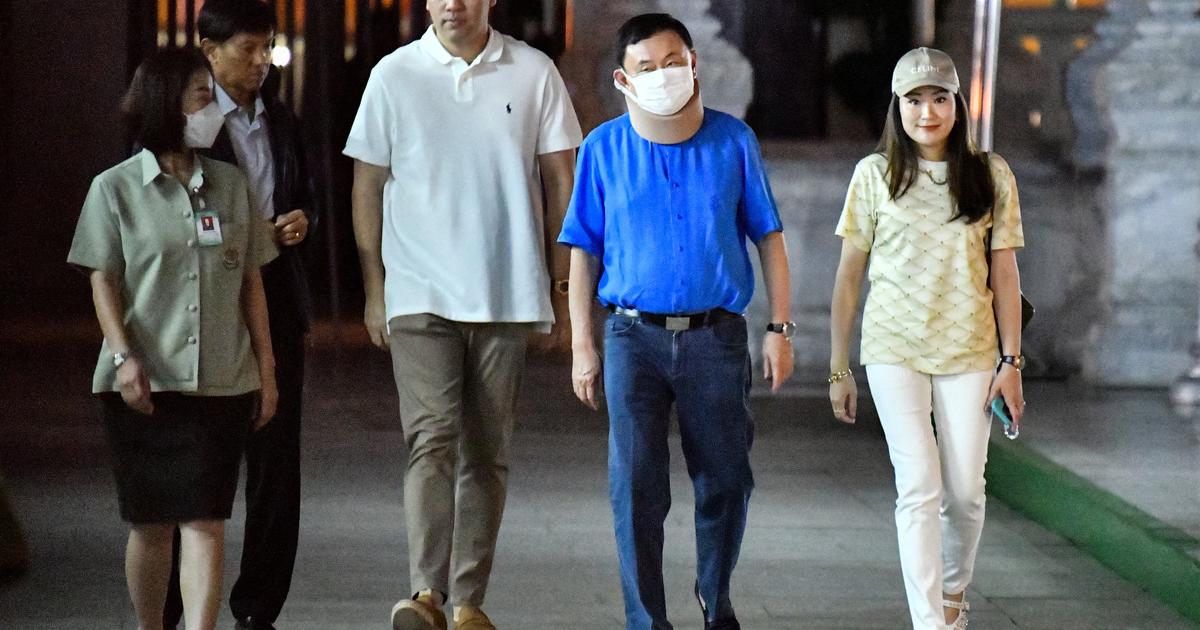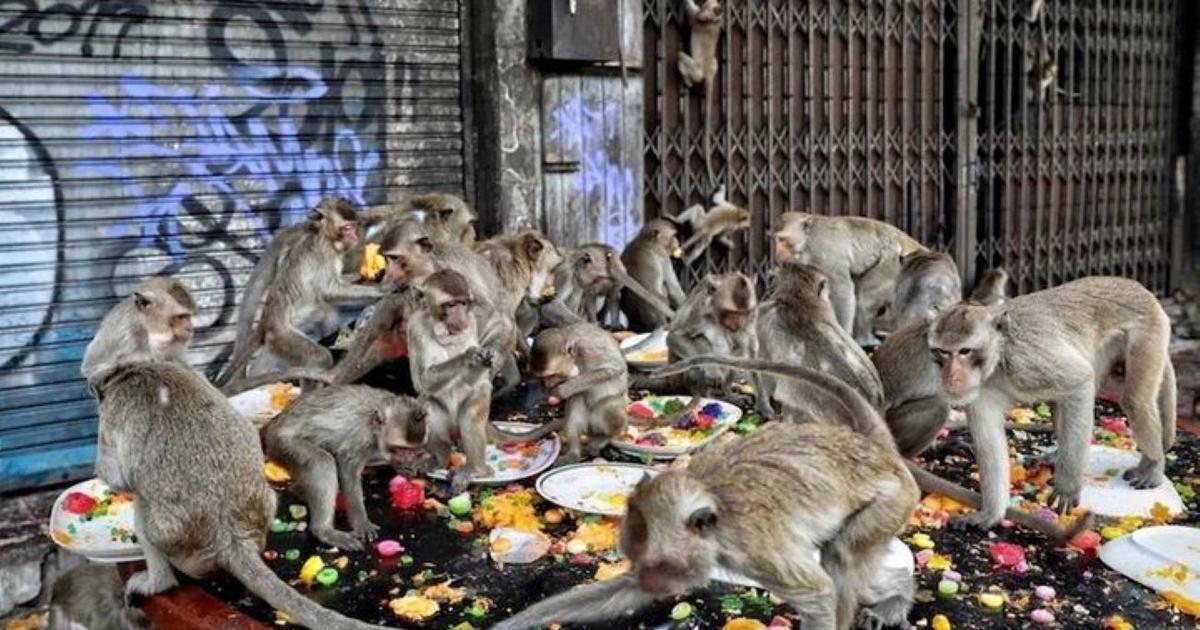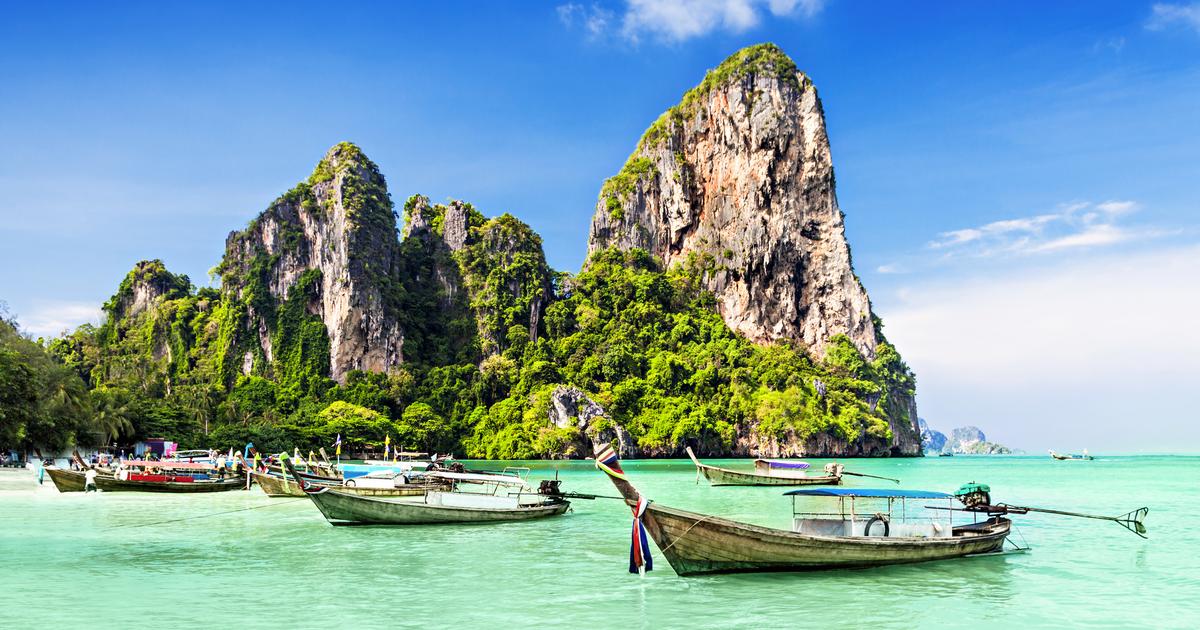What Bangkok and its eleven million inhabitants could ultimately save is hidden beneath the city, 28 meters deep in the ground.
A rickety open construction site elevator descends to the excavation site of tunnel five.
The tunnel is a sewer.
Five meters in diameter, nine kilometers long.
It begins in the Nong Bon neighborhood and ends in the Chao Praya, Bangkok's great river that meanders through the Thai capital like an untamed animal.
Water is becoming a major threat to Bangkok.
There are forecasts that the Southeast Asian megacity could be completely flooded by 2030.
Heavy rainfall there will increase in the next century - especially towards the end of the monsoon season in October and November.
Like other megacities in Southeast Asia - Jakarta, Singapore, Manila, Saigon - the city is one of the fastest sinking cities in the world.
In a special report by the IPCC, scientists expect the worst-case scenario to see sea levels rise by 84 centimeters by 2100.
Is water a problem?
That was not always so.
The water used to soak the soil of the smallholders during the rainy season.
Enough for the plants to get through the dry season.
The fields were then flooded for months, and the farmers moved on them in small boats.
They lived with the water.
They were dependent on it.
The water made decisions about hunger and fullness, prosperity and poverty, a good or a bad life.
Today the smallholders and their fields have long been displaced.
Now the towers of Thailand's capital rise from the delta into the air.
And now, in the juggernaut of this concrete megacity, the water is above all: a huge challenge.
Bangkok can have the water masses that occur during the rainy season
streaming down, hardly taking in anymore.
There are too few green spaces in which the floods could seep, and too much concrete - streets, forecourts, shopping malls, high-rise buildings.
Bangkok is sinking an inch every year
The gray water of a two-digit million population, toilet water, rainwater - everything has to squeeze through narrow gullies, first through smaller, then larger pipes in the ground.
That does not work.
As soon as it rains heavily, the system clogs within minutes.
Water then accumulates meters high on the streets and in people's homes.
Then there is the climate crisis: Much of Bangkok is only a few meters above sea level.
If this rises, the level of the Chao Praya River also rises.
In addition, Bangkok is sinking about an inch every year.
In this story we visit those who are particularly hard hit by the change in Bangkok and by the water.
Who don't live in the skyscrapers where they stay dry.
But almost on the ground, in the huts of the slums.
People who need to think about leaving home soon.
But we also meet those who are fighting to ensure that their city, their home, does not go under.
Have the solutions.
The rescuers of Bangkok.
So back to the construction site of tunnel five.
Somjai remembers the Bangkok of yesteryear
Somjai Lamlamai, 58 years old, lives in a tin hut between a bridge and the highway, right next to the old railroad tracks, on which freight cars with petrol tanks sometimes rush through only at night.
Everyone just calls her Somjai, which is why she should appear by her first name in this story.
Last names, she says, make no sense in her world.
Your world, that is the community behind the Makkasan Temple, in the middle of Bangkok.
The next big street with a shopping mall is only a few corners away.
Bangkok has grown tremendously since the 1970s and 1980s.
In 1984 about five million people lived in the Thai capital.
In 2020 there were more than twice as many: just under 11 million.
She sits there, her feet in blue slippers, the mask on her wrist, and is something of a contemporary witness of her city.
Somjai has lived here for more than half a century.
The Bangkok of the past, she says, has nothing to do with the Bangkok of today.
She used to buy groceries at the market for 5 baht, 13 cents, and feed her whole extended family with it.
Today ten times as much money in front and back is not enough for a warm meal that satisfies everyone.
Somjai remembers hammering the walls of her hut together with her first husband in 1983.
The tin roof laid on it.
Back then, she says, when she was very young, the smallholder fields began right behind the slum.
The highway on which the yellow-green taxis are now stuck in traffic was previously a dusty road.
After the rain, the residents often put bamboo poles on the muddy paths as step aids.
Right behind their little settlement
the forest started with big old trees.
Somjai tells: How the city grew, ring after ring, around its little world.
The cultivated fields from back then have become high-rise buildings with fitness studios.
She says: "In the past, rainwater simply rushed through the streets of our neighborhood and flowed into the nearby canal."
Today the water can no longer run off: high-rise buildings have been built right in front of the canal.
They block the water's way.
"If it rains today, the water in my hut will back up like a pool."
How water takes people's homes away
In 2011, Thailand experienced the worst flooding in decades.
800 people were killed at that time.
The disaster burned itself into the minds of many Bangkok residents, because the city was also badly affected at the time.
Six months, from May to October, is the rainy season in Bangkok.
What this means for some parts of the city was last seen at the end of October 2021.
Social help, insurance protection - not available for most of the residents.
Older people depend on younger people, on their families, on the cohesion in their neighborhoods.
How an architect tears away the concrete from the city
If you ask Kotchakorn Voraakhom that people in Bangkok are on the verge of losing their home, especially those who were born there a long time, maybe in the city, then she says, "I know".
Then she says: "These people are the reason why I keep fighting."
Voraakhom,
40, is a landscape architect from Bangkok.
She has become a celebrity in the city and beyond, one whose ideas are quoted when it comes to what can be done to save megacities like Bangkok or Jakarta or Dhaka from sinking.
She was born in a little house on Chao Praya, not poor, not rich.
Her childhood home, she says, was flooded so often that her family had to give it up at some point.
Voraakhom says that was the moment she decided to save her city.
She remembered a childhood game.
How she used to sit in the concrete parking lot behind the house, tearing small pieces of tar out of the ground - to bring out the earth below.
"It only took a few days for a little plant to grow out of the gap in the concrete."
Basically, Voraakhom is still doing the same thing today: tearing away the concrete of their city to reveal the nature underneath.
The idea is simple: In contrast to paving stones and concrete, soil and plants can store rainwater.
Instead of flooding streets and squares, it seeps away.
A bit like it used to be, in the fields of small farmers, when Bangkok was not yet the megacity of today.
Voraakhom has already planted the roof of the Tammasat University, where students now grow carrots and use the rainwater to do so.
She designed a park with an underground water reservoir that can collect 3.8 million liters of rain.
Last October, Voraakhom was at a construction site near the Lumphini Park, where her latest project is underway: the concrete lining of a small canal is being torn down by excavators.
The canal is widened as it used to be.
So that he can better absorb the floods.
Next to and above it are green paths, trees, lots of areas that can also store water.
She says: “We mustn't be afraid of the water.
We have to live with him.
We have to make room for him for that. "
Voraakhom's second big concern is that the city should again contain more space for all the people who come into their lives.
More space to meet, to briefly escape the smog and the traffic and the noise.
Move around, clear your mind, stay healthy.
“Bangkok has become such a tough city.
Where else should people meet, except in an expensive café or a shopping mall? ”She asks.
Places where people briefly meet are so important in a city where many are at home in just a few square meters.
And especially in the pandemic, where kindergartens, playgrounds and fitness studios are often closed.
Public parks, walking paths, small oases to breathe.
What Bangkok definitely doesn't need more of are streets.
In Voraakhom's eyes, they are everything that prevents Bangkok from being a city of the future: tar, exhaust fumes, space consumption.
She says, "We could have so many parks if we had fewer highways."
The city is famous for traffic chaos and traffic jams.
Traffic has decreased significantly in the corona crisis due to curfew, home office, shutdown and the end of tourism.
Cars have been coming back, however, since measures were relaxed.
But something is happening there too.
In the coming years, the city's subway system is expected to grow hundreds of kilometers.
Completely new lines are created, above and below ground.
In the year 2029, the Bangkok subway network, according to the "Mass Rapid Transit Master Plan", will be more than 550 kilometers.
What does the future of Bangkok look like?
There is a novel by the Thai writer Pitchaya Sudbanthad that has been widely read beyond Thailand in recent years.
"When Bangkok wakes to rain" is his name.
The story ends in dystopia.
Parts of Bangkok have perished, only the rich were able to save themselves on dry, higher ground.
It says: "Everything will disappear at some point."
Will Bangkok have a future?
And what does it look like, especially for the poor in town?
Are the rescue measures enough to keep such a dystopia a dystopia?
The construction workers and engineers who can be met underground at Canal Five are convinced that they can save their city.
There are more tunnels like this, they say, and some of the tubes are already in operation.
There are always setbacks, says the architect Voraakhom.
When a square is paved with the umpteenth shopping mall instead of a park.
But she also says that her city will survive: »I love Bangkok.
I can't sit around and wait for my city to go under. "
This contribution is part of the Global Society project
Expand areaWhat is the Global Society project?
Reporters from
Asia, Africa, Latin America and Europe
report under the title “Global Society” - on injustices in a globalized world, socio-political challenges and sustainable development.
The reports, analyzes, photo series, videos and podcasts appear in a separate section in SPIEGEL's international department.
The project is long-term and is supported by the Bill & Melinda Gates Foundation (BMGF).
A detailed FAQ with questions and answers about the project can be found here.
AreaWhat does the funding look like in concrete terms?
The Bill & Melinda Gates Foundation (BMGF) has been supporting the project since 2019 for an initial three years with a total of around 2.3 million euros - around 760,000 euros per year.
In 2021, the project was extended by almost three and a half years until spring 2025 on the same terms.
Are the journalistic content independent of the foundation?
Yes.
The editorial content is created without the influence of the Gates Foundation.
Do other media have similar projects?
Yes.
Big European media like "The Guardian" and "El País" have set up similar sections on their news sites with "Global Development" and "Planeta Futuro" with the support of the Gates Foundation.
Have there already been similar projects at SPIEGEL?
In the past few years, SPIEGEL has already implemented two projects with the European Journalism Center (EJC) and the support of the Bill & Melinda Gates Foundation: the “Expedition ÜberMorgen” on global sustainability goals and the journalistic refugee project “The New Arrivals” within the framework several award-winning multimedia reports on the topics of migration and flight have been produced.
Where can I find all publications on global society?
The pieces can be found at SPIEGEL on the topic Global Society.










/cloudfront-eu-central-1.images.arcpublishing.com/prisa/KMEYMJKESBAZBE4MRBAM4TGHIQ.jpg)



